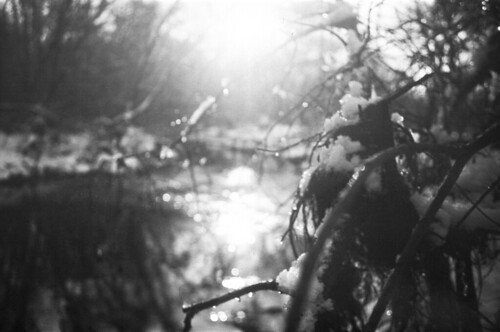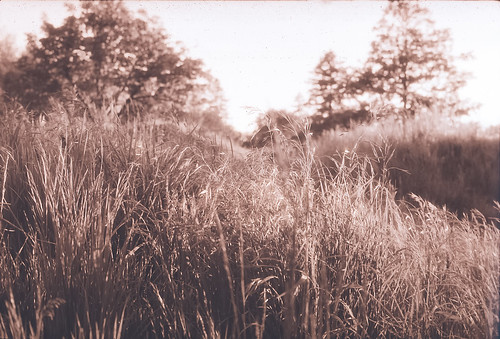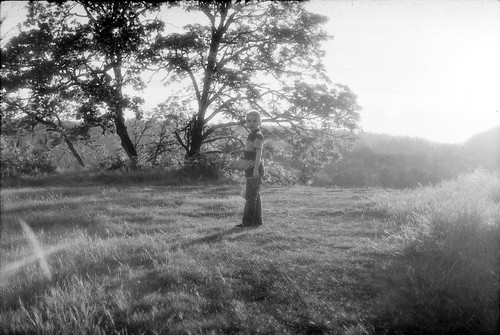The one problem with doing Reversals yourself is the harsh chemicals. Potassium Permaganate is one thing (Found in fish medicine to treat Ich (pronounced Ick)). The other chemical is Sulfuric Acid. That is battery acid! VERY bad chemical to have. It's ... well... acid! Let's face it Acid is not person friendly, let alone safe and kid friendly! Those with kids, not the easiest to have these kind of chemicals around.
The other option is to send to Dr5.com, which is a great way to get some absolutely stunning reversals! However, what if you are not in a place where shipping a roll of film to DR5 is economical... What about doing it yourself without using harsh chemicals... Is there a way?
Apparently there is. +Kelly-Shane Fuller, who is known for his E3 reversal in modern terms using HC-110 and C-41 to get E3 reversals with more stable colour dyes than the original E3 process...
Well.... lets look at his Chemically Safe B&W Reversal process..
For one, you use Hydrogen Peroxide (available the world over at drug stores) 3% which is as safe as it gets, considering you can pour it over an open wound to clean it out. The other is Vinegar... Good old fashioned White Vinegar, which is a great thing... You can mix it to make a B&W bleach, or... pour it on your fries....
So he made a 260mL solution... How? Let's get into it;
250mL Hydrogen Peroxide 3%
10mL (2 tsp) White Vinegar
Heat to 150°F
So that's it...
Steps required;
Develop Film as normal using your favorite B&W developer...
BLEACH 6 Minutes
Fully Expose to light (take out of the container and off the reel)
Re-Develop to finality (you can reuse your Developer you poured out)
FIX
Wash
Photoflo
Dry
Then you get some beautiful slides!
 |
| Kodachrome 64 (Expired) As B&W Slide |
Then there is Polypan F (care of your's truly)... It is absolutely stunning! I couldn't believe the tonality he got out of itI sent him a few rolls of Polypan F down and he finally got around to trying it out... Man.... Not only did I get him hooked on Polypan (It's an easy thing to do) but he is stunned too over the amazing tonality and look of this film as a reversal.
I'm all for B&W reversal.. And the fact that you can now use a much much MUCH more kid friendly version of the bleach..
Thanks Kelly-Shane Fuller!
Stay tuned as photos of the film on a light table and under room light to show they are "SLIDES" will be posted later..
Can't wait to try this process myself!!
So until next time... Let's keep those shutters firing!
All images were used with permission from the original author and are direct linked from his Flickr stream.
Images are protected under International Copyright Law. Use without permission is strictly prohibited.



Thanks a lot for sharing!! It worked unexpectedly well even if the emulition has tiny cracks all over the highlights in my case, probably due to using caffenol as a developper and a kodak gold color film. But either way, it's surprising and eve got some subtle color.
ReplyDeleteChears!
No problem! I cannot believe how simple it really is. I have yet to try it myself (personally) but as this has been done multiple times by the person who gave me the recipe, I would have to say it is a definite keeper!
DeleteCertainly beats using strong acid and harsh chemicals!
The first time I heard about this "recipe" was trough my own research in 2013, http://www.filmlabs.org/docs/citric-hydrogen-peroxide-bleach.pdf But maybe someone got to the same conclusion as I did :) The good thing is that many people are using it, and that's very positive, since it is a much safer version than the conventional potassium permanganate and potassium dichromate ones
ReplyDeleteAndi, the reason that it might have tiny cracks on the emulsion must not be from the caffenol itself, but because the bleach is not stable, if you haver pH paper strips around, check if the value is around 2, above that, hydrogen peoxide is unstable, that must be the reason for the blisters. Also, 3% is a very low concentration, and 150F is also too high temperature. What I use normally is a lower temperature, around 96F and a concentration of at least 5%. If you can only find 3% hydrogen peroxide, you can boil it according to the right percentage. Hydrogen peroxide decomposes at higher temperatures than the water boiling temperature. Again, try incresing the concentration of acetic acid (or vinegar) it seems too low... all best
ReplyDeleteHow long are you Exposing the film to light for?, I tried the process with the Peroxide bleach. A positive was achieved during the second development, but quickly disappeared when I added the fixer. all that was left was a dark negative image. I used Ilford Pan 50 in D76 1+3 @ 15mins, Bleach for 6mins, Re-exposure was continuious (on both sides) for 10mins, The re-dev in D76 1+3, then Fixed in Agfa g333c.
ReplyDeleteWhat do you think should I add more time to the re-exposure or dilute the developer and fix?
I am having this same problem with hp5 using ilfosol 3 as my developer. I follow the bleach process exactly and have the same problem, fixer causing the positive image to revert to a darker negative. Were you able to figure out a solution? Thanks.
DeleteThe sodium sulfite is for the clearing bath, and is optional. It could be the light source you're using, avoid using florescent, UV, and sunlight. For the re-exposure you need a bright light (tungsten or halogen light) 25-30 cm away from the light source for about 1 minute....
DeleteWatch out! You are making highly corrosive paracetic acid when you mix peroxide and vinegar (acetic acid). This IS a harsh chemical. Do NOT use it without an acid gas respirator, forced ventilation, face guard, gloves, and plastic apron.
ReplyDeleteIs it possible to do this process to a negative black and white film, say Tri-X for example. I've been attempting to make a slide like positive on my negatives. So far I have come close, but not close enough as my scans still required to be negatives in order to be proper. I also have Kentmere 100 in my arsenal as well. Thanks!
ReplyDeleteAbsolutely you should be able to. I have seen it done with many different films by the guy who devised this type of reversal process..
DeleteI'm a fan of Polypan F and will try this thing ASAP. Does the bleach bath really needs heating at 150°F for processing, or just for mixing it?
ReplyDeleteI'd love to answer that question, however I'm, unfortunately, in no possible way to answer that truthfully..
DeleteI believe it does have to be 'hot' so to speak, as the person who developed this method found that you had to increase the temperature.. It seems a bit warm to me too, but if it works, it works.
Hallo!
ReplyDeleteI'm big fan of B/W reversal film. I use mostly SCALA or ORWO UN54+. This is "universal" film, usable as simple negative (100 ASA) or as reversal (125 ASA, may be is better 160 ASA). ADOX Silvermax is usable as reversal film too (practical is SCALA, too 160 ASA).
Hello, I'm very interested in this project and alternative way of making positives. I have some questions:
ReplyDeleteOther blogs suggest no to use sunlight for reexposing, have you done it on full strenght sun light?
How much rolls can be bleached with one liter of a solution?